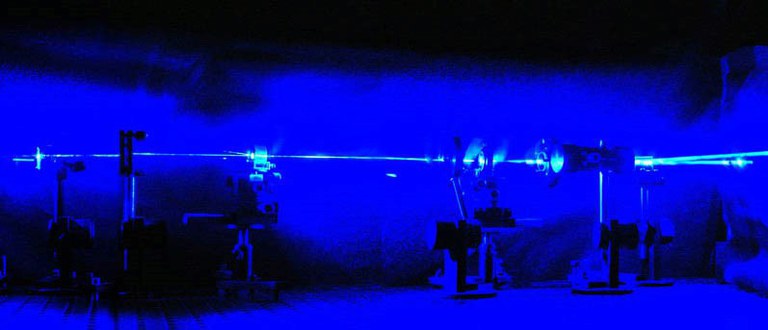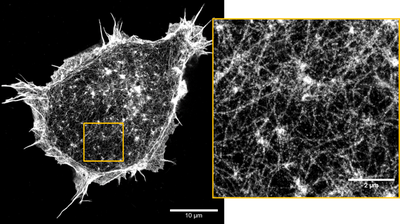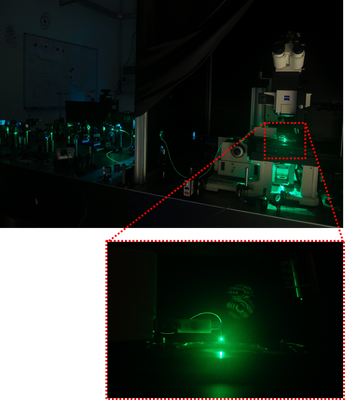LENS (Florence, Italy)
Research highlights
LENS
Laboratorio Europeo di Spettroscopie Non
Lineari, Sesto Fiorentino (Florence), Italy

Cold Matter
Strongly correlated superfluid order parameters from dc Josephson supercurrents (European Research Council GA no. 307032 QuFerm2D, 2020): observation of dc Josephson supercurrents in strongly interacting fermionic superfluids across a tunnelling barrier in the absence of any applied potential difference. This work suggests that coherent Josephson transport may be used to pin down superfluid order parameters in diverse atomic systems, even in the presence of strong correlations [Science 369, 84-89 (2020)].
Spectroscopy
Ultrafast time resolved visible-pump/IR-probe spectroscopy of the Iminothioindoxyl photoswitch (Access from University Medical Center Groningen, 2019): Iminothioindoxyls (ITIs) show a band separation of over 100 nm, isomerize on picosecond time scale and thermally relax on millisecond time scale. Using a combination of advanced spectroscopic and computational techniques, we provide the rationale for the switching behavior of ITIs and the influence of structural modifications and environment, including aqueous solution, on their photochemical properties [Nature Communications 10, 2390 (2019)].
Biochemistry
Linking the load-dependence of myosin's working stroke to the release of phosphate and ADP (Access from University of Massachusetts, 2019): Studying the mechanics of proteins under force is of general interest, since all proteins experience forces inside the cell and this setup is a unique tool to study their effect on the single proteins in vitro. Over the past years, this technique has been successfully applied to various proteins, thus revealing new information on the influence of force on their kinetics and conformation changes [Nature Communications 9, 2844 (2018)].
Phase Transitions
Confirmation of pressure-induced polymerization in co-crystals of arenes and perfluoroarenes via infrared spectroscopy (Access from Julius-Maximilians-Universitaet Wuerzburg, 2019): We have observed the extraordinary stability of 1:1 co-crystals of naphthalene and anthracene with octafluoronaphthalene and, hence, of the arene-perfluoroarene interaction at high pressures of up to 20-25 GPa, respectively, where they show irreversible phase transitions. These phase transitions are proposed to be associated with pressure-induced polymerization reactions. We performed infrared and Raman spectroscopic studies at high pressure and on the quenched high-pressure phases. Vibrational spectroscopy is the major tool which will allow us to follow experimentally the change from sp2 to sp3 carbon in aromatic compounds [Awaiting publication].
Projects performed by external users >>
Further application highlights
Lasers and Water Lasers for Clean Energy
Expertise
LENS was born as a European scientific research centre providing advanced laser, spectroscopic and microscopy facilities for researchers from European countries and promoting and facilitating the exchange of ideas, scientific techniques, and technical skills. From atomic physics to photochemistry, biochemistry and biophysics, from material science to photonics and to solid and liquid state physics, all of these fields share the same fundamental methodology: the use of laser light to investigate and manipulate matter.

At LENS we propose several different facilities in cutting-edge research:
- Single-molecule localization microscope: 3D tracking and super-resolution, 2D Single Molecule Tracking
- Ultrafast force-clamp spectroscopy
- Light-sheet microscopes: for imaging cleared tissue, for high-throughput and high-resolution 3D imaging
- Scanning Near-field Optical Microscope
- Low-temperature and time resolved confocal microscope
- Time-resolved Transient Grating Experiments and Optical Kerr Effect, based on picosecond or femtosecond laser pulses
- Time-Domain Spectroscopy with Pulses from THz to UV, based on femtosecond laser conversion, including multidimensional spectroscopy
- Direct laser writing with NanoScribe
- Ultracold Quantum Matter Laboratories
- Light for quantum technologies
Equipment offered to external users
For full details, please see https://lens.unifi.it/access-facilities/

- Single-molecule localization microscope:
- 3D tracking and super-resolution - Wide-field Single Molecule Microscope. Several laser lines are available for excitation of fluorescent probes in the visible range combined with multiple fluorescence filters to select the fluorescence emission. The same setup allows imaging of biological structures with 3D super-resolution STORM with multiple colours with about 10 nm accuracy.
- 2D Single Molecule Tracking - commercial epifluorescence microscope equipped with EMCCD camera, a dual viewer for simultaneous two colour imaging and thermostatted system
- Ultrafast force-clamp spectroscopy
- The ultrafast force-spectroscopy setup is primarily used in studies of mechanical properties of proteins, molecular motors, DNAs, etc. It is based on a 1064 nm dual-trap optical tweezers.
- Light-sheet microscopes: for imaging cleared tissue, for high-throughput and high-resolution 3D imaging
- Tissue transformation facility (CLARITY and SHIELD based)
- Biochemical lab equipped with tools and reagents for tissue clearing and staining.
- Light-sheet microscope for sub-cellular imaging of cleared murine organs.
- Double-inverted light-sheet microscope for sub-cellular imaging of human tissue slabs (1 mm thick).
- GPU cluster for image processing

- Scanning Near-field Optical Microscope
- equipped with sources and detectors in the visible and near-infrared. The setup is also combined with a Confocal Microscope and a Dark-Field Microscope.
- Low-temperature and time resolved confocal microscope
- custom confocal microscope equipped with a low-vibration continuous He-flow cryostat (8-330 K) which in turn is mounted on x-y translation stages. The excitation wavelengths span the range 400 – 900 nm, while the detection is in the interval 350 – 1600 nm
- Time-resolved Transient Grating Experiments and Optical Kerr Effect, based on picosecond or femtosecond laser pulses
- green laser is the single-mode laser (2 watt at 532 nm wavelength) used to probe the impulsive grating induced in the sample by picosecond laser pulses (25 picosecond pulse duration at 1064 nm)
- Time-Domain Spectroscopy with Pulses from THz to UV, based on femtosecond laser conversion, including multidimensional spectroscopy
- converting optical femtosecond laser pulse into the THz frequency by non-linear processes in air plasma. Broad band spectrum covering frequency from tenths to tens of THz
- set-up for transient absorption spectroscopy in the NIR-VIS-UV regions
- 2D ES Spectroscopy with ultra-short pulses (<=10 fs)
- 2D IR Spectroscopy in the MIR region
- Direct laser writing with NanoScribe
- Ultracold Quantum Matter Laboratories
- State-of-the-art and versatile experimental set-ups to produce and investigate ultracold quantum matter
- Microscope objectives for high resolution imaging and manipulation of the quantum gases
- Digital Micromirror devices for tailoring arbitrary optical potentials
- Light for quantum technologies
- High repetition rate heralded single photon generation and addition based on pulsed parametric down-conversion;
- High frequency, time-domain, homodyne detection for the tomographic reconstruction of pulsed quantum states of light;
- Advanced schemes for the manipulation and analysis of non-classical light at the single-photon level over multiple spectrotemporal modes;
- Telecom fibre components: Single-photon detectors, wide-bandwidth homodyne detectors, high-speed modulators;
- Ultra-fast electronics;
- Cryo-free cooler at 3K, with flexible optical access;
- Time-resolved and correlation measurements for the characterization of quantum emitters at the single photon level;
- Advanced schemes for the detection and the quantum control of individual electronic and nuclear spins in diamond, based on a combination of optical scanning microscopy and magnetic resonance tools;
- Femtosecond amplified lasers for diamond micro-fabrication and deterministic defect activation

